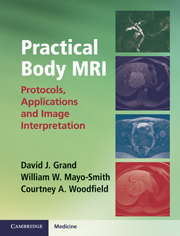Book contents
- Frontmatter
- Contents
- Preface
- To the reader
- Acknowledgments
- Glossary of terms andabbreviations used in Body MRI
- Section 1 Body MRI overview
- Section 2 Abdomen
- Section 3 Pelvis
- Chapter 7 The female pelvis: uterus
- Chapter 8 Adnexa
- Chapter 9 Female urethra
- Chapter 10 Pelvic floor / prolapse
- Chapter 11 Imaging of the pregnant patient
- Chapter 12 MRI of male pelvis
- Chapter 13 Rectal MRI
- Section 4 MRI angiography
- Index
Chapter 11 - Imaging of the pregnant patient
from Section 3 - Pelvis
Published online by Cambridge University Press: 05 November 2012
- Frontmatter
- Contents
- Preface
- To the reader
- Acknowledgments
- Glossary of terms andabbreviations used in Body MRI
- Section 1 Body MRI overview
- Section 2 Abdomen
- Section 3 Pelvis
- Chapter 7 The female pelvis: uterus
- Chapter 8 Adnexa
- Chapter 9 Female urethra
- Chapter 10 Pelvic floor / prolapse
- Chapter 11 Imaging of the pregnant patient
- Chapter 12 MRI of male pelvis
- Chapter 13 Rectal MRI
- Section 4 MRI angiography
- Index
Summary
Pregnant patient pelvic imaging protocol
Indications
This protocol is used to evaluate adnexal masses and fibroids in pregnant patients. It can also be used to evaluate nonspecific pelvic pain during pregnancy and appendicitis.
Preparation
IV contrast agent: None
Oral contrast agent: None
Have the patient void prior to the start of the study
Cover from iliac crests through symphysis pubis. If pathology extends above or below these levels, increase coverage
All T2 single-shot fast-spin echo sequences can be run without breath-hold to continuously cover the pelvis and pathology as one series.
Exam sequences
(1) Coronal T2 single-shot fast-spin echo (large field of view to cover at least ½ kidneys) – Assess presence and location of kidneys. Evaluate for hydronephrosis. Identify T2-bright and T2-dark lesions.
(2) Sagittal T2 single-shot fast-spin echo – Identify T2-bright and T2-dark lesions.
(3) Axial T2 single-shot fast-spin echo – Identify T2-bright and T2-dark lesions.
(4) Axial T1 in- and out-of-phase BH – Identify T1-bright lesions and microscopic fat.
(5) Axial volume-interpolated gradient echo BH – Characterize T1-bright signal in lesions. Identify blood products.
- Type
- Chapter
- Information
- Practical Body MRIProtocols, Applications and Image Interpretation, pp. 106 - 120Publisher: Cambridge University PressPrint publication year: 2012

